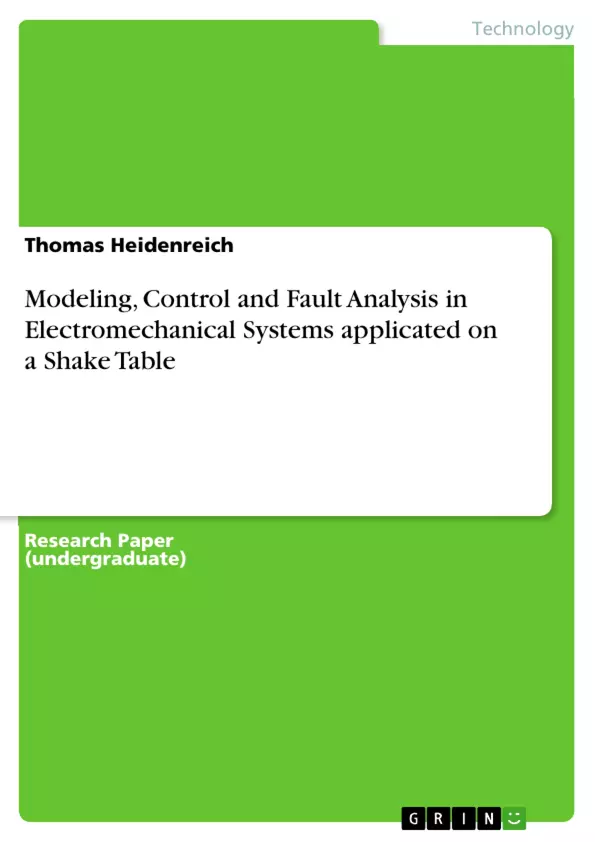A control and fault detection is designed for a shake table with mounted structure. The focus is on the modeling and analysis, controller design and its technical implementation.
Inhaltsverzeichnis (Table of Contents)
- Introduction
- 1 System Description
- 1.1 Hardware
- 1.2 Software
- 2 Modeling
- 2.1 Modeling of the Shake Table
- 2.1.1 Continuous Transfer Function
- 2.1.2 Continuous State Space Representaion
- 2.1.3 Discrete Transfer Function
- 2.1.4 Discrete State Space Representaion
- 2.2 Modeling of a Frame
- 2.2.1 Time Continuous Transfer Function
- 2.2.2 Time Continuous State Space Representation
- 2.2.3 Time Discrete Transfer Function
- 2.2.4 Time Discrete State Space Representation
- 2.1 Modeling of the Shake Table
- 3 Control
- 3.1 Control of the Shake Table
- 3.1.1 State Controller
- 3.1.2 State Controller with preset Integrator
- 3.2 Shake Table Observer
- 3.2.1 Complete Observer
- 3.2.2 Reduced Observer
- 3.3 Control of the Shake Table with a Frame
- 3.3.1 State Controller
- 3.3.2 State Controller with preset Integrator
- 3.1 Control of the Shake Table
- 4 Fault Detection
- 4.1 Tolerance Band Method
- 4.1.1 Constant Band Method
- 4.1.2 Proportional Band Method
- 4.2 Residual Method
- 4.3 Anti Jitter Automatism
- 4.4 Application in the real System
- 4.5 Further Ideas of Fault Detection Methods
- 4.5.1 Finite State Machine analyzing Reference Velocity
- 4.5.2 Integration of the Table Acceleration
- 4.1 Tolerance Band Method
Zielsetzung und Themenschwerpunkte (Objectives and Key Themes)
This research project investigates the modeling, control, and fault analysis of electromechanical systems, specifically focusing on a shake table. The project aims to develop and analyze control strategies for the shake table, including the design of state controllers and observers, while also exploring different fault detection methods for identifying potential malfunctions. Key themes explored in the project include: * **Modeling of the Shake Table and Frame:** The project establishes accurate mathematical models for the shake table and a mounted frame, including both continuous and discrete representations. * **Control Strategies:** Different control strategies are investigated, including state feedback control, state controllers with preset integrators, and the implementation of observers for estimating system states. * **Fault Detection Methods:** Various fault detection methods are explored, such as the tolerance band method (constant and proportional), the residual method, and the development of an anti-jitter mechanism. * **Real-World Application:** The project aims to apply the developed models, control strategies, and fault detection techniques to the real shake table system for validation and practical evaluation. * **Further Fault Detection Methods:** The project explores potential future fault detection methods using techniques like finite state machine analysis and integration of table acceleration data.Zusammenfassung der Kapitel (Chapter Summaries)
This section presents a summary of the chapters excluding the conclusion, final chapter, and any sections containing major revelations or spoilers. * **Introduction:** This section provides a brief overview of the project's motivation, goals, and the overall scope of the work. * **System Description:** This chapter presents a detailed description of the shake table system, covering the hardware components such as the shake table itself, its motor, sensors, and the control unit. It also describes the software used in the system. * **Modeling:** This chapter focuses on developing mathematical models for both the shake table and the frame mounted on it. It includes the derivation of continuous and discrete transfer functions and state space representations for both components. * **Control:** This chapter covers various control strategies for the shake table. It explores the implementation of state controllers, including those with preset integrators, as well as the design and implementation of observers for state estimation. * **Fault Detection:** This chapter discusses different fault detection methods for the shake table. It includes a detailed exploration of the tolerance band method, the residual method, and an anti-jitter mechanism. It also provides examples of how these methods are applied to the real shake table system. * **Further Ideas of Fault Detection Methods:** This chapter presents potential future directions for fault detection. It discusses two promising approaches: using finite state machine analysis to analyze reference velocity and integrating table acceleration data for fault detection.Schlüsselwörter (Keywords)
The primary focus of this research project lies in the modeling, control, and fault analysis of electromechanical systems, with particular emphasis on a shake table. Key concepts and terms include: shake table, electromechanical system, modeling, control, state feedback, observer, fault detection, tolerance band method, residual method, anti-jitter, finite state machine, acceleration integration.
Excerpt out of 85 pages
- scroll top
- Quote paper
- Dipl-Ing. Thomas Heidenreich (Author), 2004, Modeling, Control and Fault Analysis in Electromechanical Systems applicated on a Shake Table, Munich, GRIN Verlag, https://www.grin.com/document/113105
Look inside the ebook



